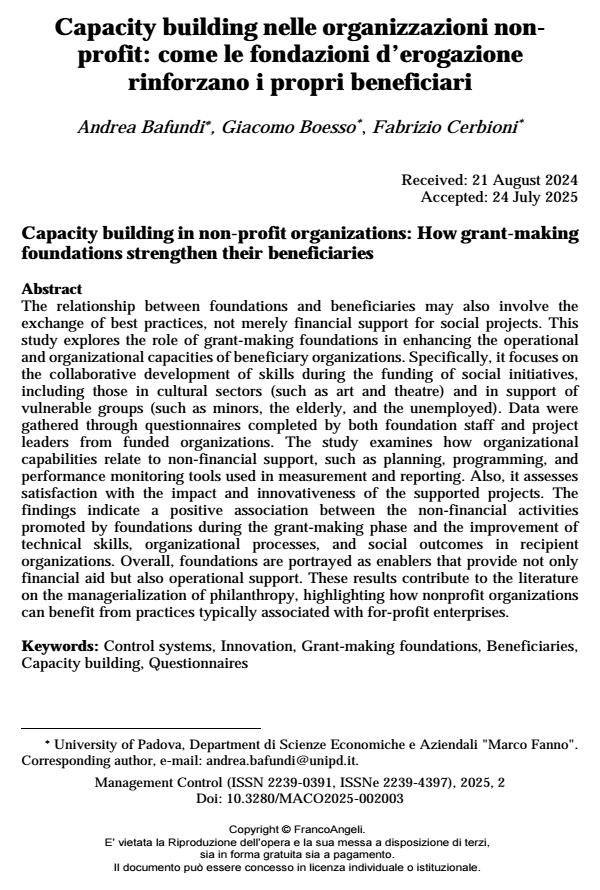Capacity building nelle organizzazioni nonprofit: come le fondazioni d’erogazione rinforzano i propri beneficiari
Titolo Rivista MANAGEMENT CONTROL
Autori/Curatori Andrea Bafundi, Giacomo Boesso, Fabrizio Cerbioni
Anno di pubblicazione 2025 Fascicolo 2025/2
Lingua Inglese Numero pagine 22 P. 39-60 Dimensione file 111 KB
DOI 10.3280/MACO2025-002003
Il DOI è il codice a barre della proprietà intellettuale: per saperne di più
clicca qui
Qui sotto puoi vedere in anteprima la prima pagina di questo articolo.
Se questo articolo ti interessa, lo puoi acquistare (e scaricare in formato pdf) seguendo le facili indicazioni per acquistare il download credit. Acquista Download Credits per scaricare questo Articolo in formato PDF

FrancoAngeli è membro della Publishers International Linking Association, Inc (PILA)associazione indipendente e non profit per facilitare (attraverso i servizi tecnologici implementati da CrossRef.org) l’accesso degli studiosi ai contenuti digitali nelle pubblicazioni professionali e scientifiche
The relationship between foundations and beneficiaries may also involve the exchange of best practices, not merely financial support for social projects. This study explores the role of grant-making foundations in enhancing the operational and organizational capacities of beneficiary organizations. Specifically, it focuses on the collaborative development of skills during the funding of social initiatives, including those in cultural sectors (such as art and theatre) and in support of vulnerable groups (such as minors, the elderly, and the unemployed). Data were gathered through questionnaires completed by both foundation staff and project leaders from funded organizations. The study examines how organizational capabilities relate to non-financial support, such as planning, programming, and performance monitoring tools used in measurement and reporting. Also, it assesses satisfaction with the impact and innovativeness of the supported projects. The findings indicate a positive association between the non-financial activities promoted by foundations during the grant-making phase and the improvement of technical skills, organizational processes, and social outcomes in recipient organizations. Overall, foundations are portrayed as enablers that provide not only financial aid but also operational support. These results contribute to the literature on the managerialization of philanthropy, highlighting how nonprofit organizations can benefit from practices typically associated with for-profit enterprises.
Parole chiave:Control systems, Innovation, Grant-making foundations, Beneficiaries, Capacity building, Questionnaires
Andrea Bafundi, Giacomo Boesso, Fabrizio Cerbioni, Capacity building nelle organizzazioni nonprofit: come le fondazioni d’erogazione rinforzano i propri beneficiari in "MANAGEMENT CONTROL" 2/2025, pp 39-60, DOI: 10.3280/MACO2025-002003